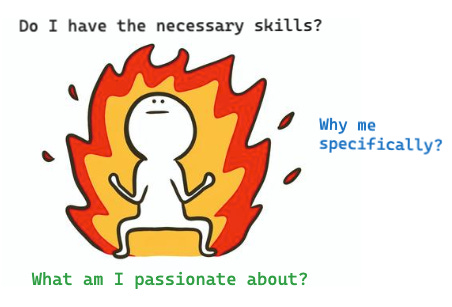Founder’s Journal (part 2): How to Identify A Startup Idea?
Pay Attention and Evaluate your Founder-Fitness
This post is written for aspiring first-time founders and for myself to look back at my startup journey.
In this post, you will find 2 lessons I have gained to answer this question: “How do you identify a startup idea?”
Hi friends 🥰
How are you doing these days?
Since we announced that MO is ending, we've been touched by all the encouraging words from our students, community, instructors, and friends. Everyone is very understanding and respectful of our decision, wishing us the best on our next journey. We are truly grateful for that.
One of the questions we've been asked is whether we will open MO again.
To be honest, we are not sure.
But this question has made me realize the entrepreneurial spirit in me and perhaps I will build something again in the future 😃
One question leads to another and I caught myself wondering the other week:
“If I were to build a startup again in the future, what would I do differently? What would I take from my experience at MỞ?”
Specifically…
As a start…
How would I approach this question differently in the future:
“How do you identify a startup idea?”
This question will kick-start my reflection on the past 4 years attempting to build a startup. I hope you will learn something from my reflection journey 🥰
Let’s begin!
How do you identify a startup idea?
It’s interesting how often this question comes up as if the idea is the single most crucial piece of building a startup.
It’s important, yes, but it’s just the beginning in my opinion. The journey from idea to reality is long, winding, and often unpredictable.
Reflecting on MO, I realize that the idea didn’t just appear fully formed. It was an iterative process, shaped by experiences, observations, and a fair amount of curiosity.
The original concept for MO wasn’t mine; it was my co-founder Tung’s. The idea emerged out of his boredom and curiosity during COVID-19:
"Why not leverage my existing brand to help talented young Vietnamese share their passion with others?"
This got me thinking about the process of idea generation and how founders often come up with an idea in the first place.
Ideas and problems are often already around us, quietly forming in the background, waiting for the right moment to surface. It’s our job to notice them, to pay attention to what we think, what we care about, and what excites us.
Learning #1: Pay Attention
Lenny Rachitsky, in his research on successful consumer businesses, emphasizes that great startup ideas often come from paying attention - whether it’s to our problems, curiosities, or the world around us.
He identified a few strategies that consistently lead to strong ideas:
Pay attention to your own problems, and solve them. (~30% of companies)
Pay attention to your curiosity, and tinker. (~20% of companies)
Pay attention to what’s already working, and double down. (~18% of companies)
Pay attention to paradigm shifts, and work backward. (~15% of companies)
Brainstorm with friends, and pay attention to the four points above. (~15% of companies)
What Lenny’s research highlights is that the most compelling ideas often come from a personal connection to the problem or a genuine curiosity. It’s about tuning in to the signals that life is sending us, whether those signals are frustrations we experience, questions we ponder, or trends we observe.
In a similar vein, Mike Maples, in his podcast discussion about his book “Pattern Breakers: Why Some Start-Ups Change the Future”, expands on this idea of paying attention, but he frames it through a different lens.
He talks about three critical elements that great startup ideas often share. Two of the three are:
Inflections: These are external shifts that create opportunities for radical change. They’re the moments when the world starts moving in a new direction, and the potential for new ways of thinking, feeling, and behaving opens up.
Insights: This is the unique understanding that allows a founder to harness these inflections. It’s about seeing the future before it happens and knowing how to position your startup to be part of that future.
Looking back at MO, I can see how these ideas played out in our journey:
Pay attention to our own problems: The founders noticed a gap in Vietnamese classrooms - a safe and open environment where we can freely discuss struggles, wonders, and curiosities. This personal pain point was a key driver in shaping MO’s mission.
Pay attention to our curiosity: We were curious about how to reimagine the classroom, how to enhance social learning, and how to make online learning more effective in Vietnam. This curiosity kept us exploring, experimenting, and iterating.
Pay attention to what’s already working and doubling down: We observed what was happening in the U.S. online learning market and adapted those models to fit the Vietnamese context. We weren’t reinventing the wheel; we were taking what worked and making it our own.
Pay attention to paradigm shifts: We observed that learners and teachers were adopting online learning more because of COVID-19 and that some fractions of society are moving more towards digital learning and hybrid working. These external shifts made it possible for us to bring our online learning services to more people.
In essence, MO was born out of a combination of paying attention to both the inner world—our own problems and curiosities—and the outer world—market trends and broader societal shifts.
This is the dance of idea generation: tuning in to the signals around us and within us and then having the courage and energy to test those ideas in the real world.
Learning #2: Founder-Fit
Besides paying attention, there is the idea of ‘founder-fit’.
“Why are you the right founder for this idea/problem?”
According to Lenny, the more the following elements exist in founders, the more likely their ideas are going to succeed:
You can’t stop thinking about the idea (#love/passion)
Startups only really fail when the founder gives up. The more passionate you are about your idea, the less likely you are to do that.
In our case with MO, me and my cofounder did grow away from the original idea of online, social learning. This made us question our ongoing passion for this business.
You have the necessary skills to kick-start and sustain this idea (#skill)
What type of business are you trying to build? Do you have the necessary skills to create the product and sell the product?
In our case with MO, we had certain skills, but there was so much more we needed to learn to meet the demands of our vision. I also think sometimes having the skills could help you unlock a vision - help you identify what’s possible.
You have a unique insight into the opportunity (#unique-insight)
This unique insight might come from the founder’s experiences, pain points, or gut instincts. If a product needs to have a competitive advantage, a founder needs to also have a competitive advantage. Why are you the right founder for this specific vision? Is it your skillset? Is it your brand and expertise in this industry? Is it your deep network?
In our case with MO, we didn’t think much about this when we started. We were solely following our curiosities and questions at first, but we learned the importance of unique insights as we progressed.
These elements that Lenny points out echo the final critical element in Mike’s book: Founder-Future Fit.
Founder-future fit: The alignment between the founders and the future they envision. It’s about having the right skills, motivations, and network to not just predict the future, but to actively shape it.
Paying attention to find the idea is the first step. Evaluating if you are the right founder to bring the idea(s) to life at the right time is the second step.
When I was working on MO, I didn’t think much about having the necessary skills and unique insights. I was constantly thinking and following where this idea led me. However, having the necessary skills and unique insights is equally important as having a passion and love for an idea.
Learning Recap
To answer the question: “How do you identify a startup idea?”, aspiring founders can:
Pay attention:
To your own problems or the problems of those closest to you.
To your own wonders and curiosities.
To paradigm shifts and external changes happening around you.
To what’s already working and how you can add more value.
Evaluate your founder-future fit:
How burning is this idea to you? How frequently do you think about it?
Do you have the necessary skills to start building a prototype and sell to the first 100 B2C customers or 5 B2B customers?
What is your unique insight and advantage in this opportunity?
Skill?
Network?
Personal experience?
Deep technical knowledge?
Expertise and brand in the industry/field?
What's Next?
Now that we’ve explored the importance of paying attention to both external market signals and our internal curiosities and the importance of evaluating our founder-fitness, there are other crucial questions to consider, such as:
Is this problem big enough?
How do we know if it’s big enough to jump in?
I’ll dive into these questions in my next blog post. Stay tuned!
—
What do you think of this blog? Is there any part I can improve or expand on? Please let me know in the comment ❤️
Thanks for reading. Appreciate your presence here 🌹
—
Sources for this blog post:




Feedback from Tùng: Highlight the myth in the startup world that "if u want it enough, u can do it". Break myth: "u have need all insights, motivations and network." when u have skills and network, motivations can be unlocked easier compared to having motivations only.
Note to Fuong: Phần Learning 2 có thể được elaborate hơn với nhiều case studies?